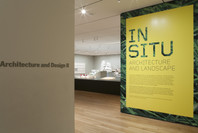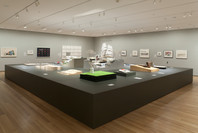Completed in 1937, Fallingwater was built as a private weekend retreat for the Pittsburgh department-store magnate Edgar J. Kaufmann in Mill Run, Pennsylvania. The bold design of the house, which seems to hover dramatically above a waterfall, was immediately hailed by critics as a masterpiece of modern architecture, catapulting Wright, its architect, into the limelight. Its strong horizontal lines, stacked cantilevered concrete terraces, and integration with the surrounding landscape make the house one of Wright’s most recognizable designs. The residence is anchored around a central hearth, the symbolic core of domestic life, with low ceilings and built-in furnishings that contribute to a sense of shelter and refuge. Fallingwater’s powerful relationship to its site, its simple materials, and its connection to nature epitomize the essential tenets of Wright’s philosophy of “organic architecture.”
This rendering is emblematic of the architect’s drawing style: seen from a slightly skewed perspective, the house appears in the upper portion of the composition, surrounded by lush vegetation. Elements of his illustration break through the drawing’s borders, a stylistic device often used by the Japanese painter and printmaker Katsushika Hokusai, whom Wright greatly admired. Wright was a lifelong collector and dealer of Japanese woodblock prints, and the influence of Japanese culture and art on his design thinking and aesthetic is apparent in this drawing.
Publication excerpt from MoMA Highlights: 375 Works from The Museum of Modern Art, New York (New York: The Museum of Modern Art, 2019)


